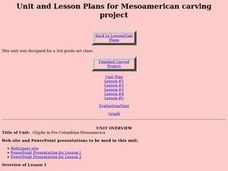Curated OER
The Physics of the Planets: How 16th and 17th Century Physicist Helped Us Understand Our Solar System
Eighth graders draw the paths of the planets in the solar system. In this astronomy lesson, 8th graders calculate speed of objects using distance and time information. They research about the work of scientists in the 16th and 17th century.
Education Outside
Papermaking
Imagine recycling food scraps and using them to make paper. The directions are all here in a seven-page packet that details several paper-making strategies.
Curated OER
A Maya Masterpiece
Students analyze the symbols presented in a Maya artifact. They create collages that depict a theme related to contemporary life in their community, and write brief analyses explaining the symbolism of the images they chose.
Curated OER
Inside The Pyramids
Students research the use of pyramids in different cultures. For this ancient civilizations lesson, students watch "Inside the Pyramids." Students conduct further research on the topic and create magazine...
Curated OER
Anasazi/Mesoamerican/Andean: Time and Cultural Passages
Seventh graders role play the position of someone in one of six different civilization groups. They research the group's development, advancement and fall of their civilization. They create a presentation to share the information with...
Curated OER
Different Ways to Count
Fourth graders investigate various number systems and ways of counting. In this various number systems and ways of counting activity, 4th graders discuss number systems from around the world. Students practice counting using...
Curated OER
Comparing the Oneota of Wisconsin to the Aztecs of Mexico
Students study the Oneota Indians of Wisconsin. They compare and contrast them to another group of natives in the Americas around the same time. They conduct intelligent discussion of the Oneotas that gives evidence to support statements.
Curated OER
Now You're Speaking My Language; Deciphering the Symbols of Early Civilizations
High schoolers explore early attempts at written language. In this early civilizations lesson, students investigate first attempts at written communication. Among the civilizations covered are Mayan, Greek, and Egyptian.
Curated OER
Artifacts: Bringing the Past Back to Life -- the Mexican Case
Young scholars examine and discuss the meanings of the various symbols in Tenochtitlan. In groups, they complete a part of the model of the city and discuss the importance of finding artifacts. Individually, they choose an a...
Curated OER
Mesoamerican Carving Project
Third graders are introduced to the use of glyphs and relief carving by Mesoamerican cultures. They complete worksheets, view PowerPoint presentations, participate in a Webquest and create an original glyph carving in sandstone.
Curated OER
Mesoamerica: The History of Central America
Students research the life of a powerful woman of the Maya Empire. They analyze the role of women in Maya society and compare them to powerful women of today in an essay.
Curated OER
Maya Math: From Zero to Nineteen
Students explore counting methods of the ancient Maya, and practice identifying Maya number glyphs.
Curated OER
Ancient Artifacts
Students research the earliest Americans. In this ancient civilizations lesson, students investigate the Mayas, Aztecs, and Incas. Students examine artifacts used in the cultures and then determine what the artifacts were used for and...
Curated OER
Maya Math: Addition and Subtraction
Learners examine how ancient Maya counted, and practice addition and subtraction using Maya number glyphs.
Curated OER
Taking the Measure of the Universe
Four fabulous activities immerse amateur astronomers into measuring objects that we cannot handle. The experiences are applied to NASA's Space Interferometry Mission, which will take measurements of planets around stars other than our...
Curated OER
Natural Resources and Ancient Cities
Students explain how the availability of natural resources has affected human settlement patterns. They recognize the interactions of human populations on environments and compare the growth of two ancient cities in relation to natural...
Curated OER
Sport as Social Ritual
Pupils become familiar with the sport that became a social ritual in ancient American cultures, examining its importance. They gain an understanding of how contemporary sports have acquired importance within modern American culture.
Curated OER
Self-Portrait Unit - Lesson #1
Fourth graders create self-portraits using artistic elements found in Hispanic culture and, specifically, the art of Frida Kahlo. The lesson can be adapted for any culture/country and requires an outside person with cultural knowledge.
Curated OER
Oklahoma Stone Soup
Class members complete activities related to the story "Oklahoma Stone Soup." First, pupils read, discuss, and answer questions about the story. Next, to incorporate math into the lesson, learners make stone soup using a variety of...
Curated OER
Poverty Point Earthworks: Louisiana's Ancient Inhabitants
Students research the prehistoric earthworks site at Poverty Point, Louisiana. They compare the Louisiana artifacts and structure to the remains and knowledge of other ancient cultures. They present their research to the class.
Facing History and Ourselves
What Does It Mean to Belong?
After reading and analyzing The 'In' Group by Eve Shalen, sixth graders consider how the categorization of people results in exclusion, discrimination, and injustice.
Curated OER
Ancient Egypt
Students discover details about ancient Egyptian funerals. In this ancient Egypt lesson plan, students compare and contrast modern funeral rites to those practiced by ancient Egyptians. Teachers may also access the suggested print and...
Curated OER
Corn: An A--Maizing Plant
Third graders examine the history of corn. In this agriculture lesson, 3rd graders discuss the history of corn and identify the corn belt on a map. Students dissect kernels of corn and discuss their observations.
Curated OER
Civilizations of the Americas
Study and compare multiple aspects of both Aztec and Inca civilizations. Young historians explain how each of the empires came to be, and how they were both defeated by the Spanish. The resource starts out as a good lesson, but is...

























